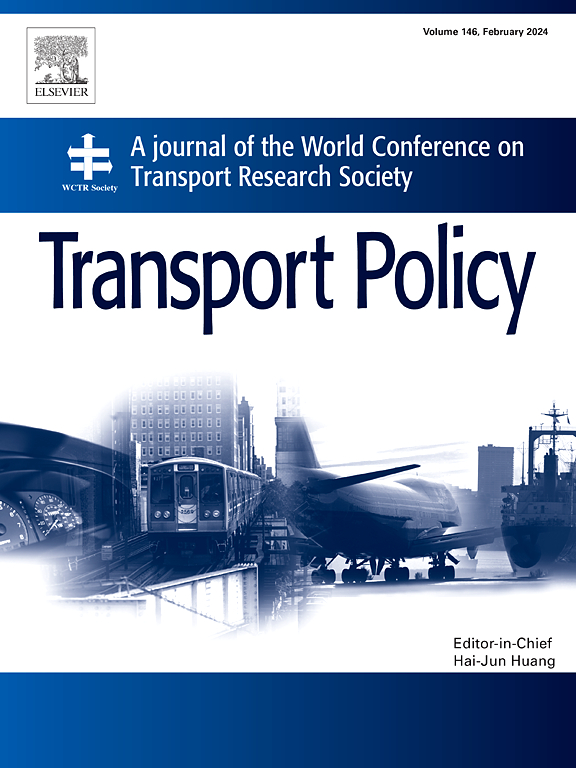How to sustainably improve passenger satisfaction of high-speed rail in China? A text mining and product service system integrated approach
IF 6.3
2区 工程技术
Q1 ECONOMICS
引用次数: 0
Abstract
The improvement of high-speed rail (HSR) passenger satisfaction from an integrated perspective of product and service is crucial for advancing several Sustainable Development Goals (SDGs) set by the United Nations, including Good Health and Well-being, Industry, Innovation and Infrastructure, and Sustainable Cities and Communities. As a critical and promising mode of public passenger transportation, ensuring the sustainable development of HSR in China necessitates a significant focus on improving passenger satisfaction. This paper presents a systematic framework from the perspective of Product-Service System (PSS) configuration, encompassing key components such as the identification and prioritization of critical passenger requirements, the prioritization of service quality improvement measures, and the optimal allocation of limited resource. Specifically, the framework involves the following steps: Firstly, text mining of social media online-reviews is utilized for the identification of key passenger requirements. Secondly, an improved Best-Worst Method under basic uncertain linguistic information environments (BULI-BWM) is employed to determine the importance of these requirements. Thirdly, an extended Quality Function Deployment (QFD) under uncertain information environments is applied to derive and prioritize service quality improvement measures. Finally, a nonlinear goal optimization model is proposed to optimize resource allocation with the aim of maximizing the level of passenger satisfaction improvement. This research, driven by a fusion of social media data, expert knowledge and experience, reveals six key passenger requirements, with current passenger concerns focusing on reliable train operations, ticket price & availability, and riding convenience. Furtherly, six targeted service improvement measures are proposed, along with optimal resource configurations to achieve the maximum improvement of passenger satisfaction levels. The findings provide practical suggestions and effective support for operational decision-making by HSR service operators and designers.
如何持续提升中国高铁乘客满意度?一种文本挖掘与产品服务系统集成的方法
从产品和服务的综合角度提高高铁(HSR)乘客满意度,对于推进联合国设定的几个可持续发展目标(sdg)至关重要,包括良好健康和福祉、工业、创新和基础设施,以及可持续城市和社区。高铁作为一种重要的、有发展前景的公共客运方式,确保高铁在中国的可持续发展,必须高度重视提高乘客满意度。本文从产品服务系统(PSS)配置的角度提出了一个系统框架,包括关键乘客需求的识别和优先排序、服务质量改进措施的优先排序以及有限资源的优化配置等关键组件。具体而言,该框架包括以下步骤:首先,利用社交媒体在线评论的文本挖掘来识别关键乘客需求。其次,采用改进的基本不确定语言信息环境下的最佳-最差方法(BULI-BWM)来确定这些需求的重要性。第三,应用不确定信息环境下的扩展质量功能部署(QFD),推导出服务质量改进措施并对其进行排序。最后,提出了以乘客满意度提升水平最大化为目标的非线性目标优化模型。这项研究融合了社交媒体数据、专家知识和经验,揭示了乘客的六大关键需求,目前乘客关注的重点是可靠的列车运营、票价和安全;可用性,以及骑行的便利性。此外,提出了六项有针对性的服务改善措施,以及优化资源配置,以最大限度地提高乘客满意度。研究结果为高铁运营商和设计者的运营决策提供了切实可行的建议和有效的支持。
本文章由计算机程序翻译,如有差异,请以英文原文为准。
求助全文
约1分钟内获得全文
求助全文
来源期刊

Transport Policy
Multiple-
CiteScore
12.10
自引率
10.30%
发文量
282
期刊介绍:
Transport Policy is an international journal aimed at bridging the gap between theory and practice in transport. Its subject areas reflect the concerns of policymakers in government, industry, voluntary organisations and the public at large, providing independent, original and rigorous analysis to understand how policy decisions have been taken, monitor their effects, and suggest how they may be improved. The journal treats the transport sector comprehensively, and in the context of other sectors including energy, housing, industry and planning. All modes are covered: land, sea and air; road and rail; public and private; motorised and non-motorised; passenger and freight.
 求助内容:
求助内容: 应助结果提醒方式:
应助结果提醒方式:


